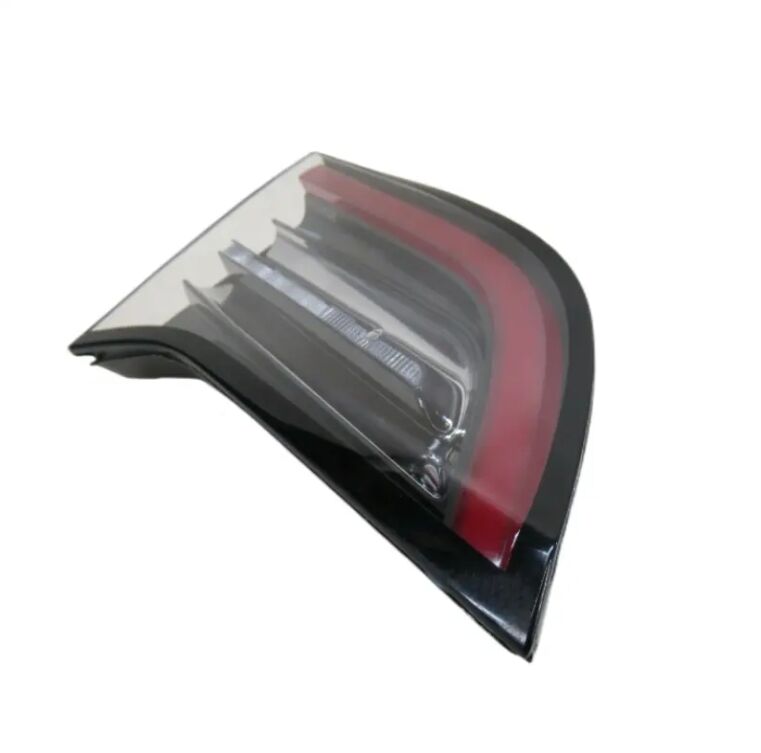มีไฟท้ายรถยนต์กี่ประเภทที่มีให้เลือกใช้
ไฟท้าย ไม่ได้มีดีแค่ไฟท้ายสีแดงที่ดูเหมือนธรรมดา แต่มีหลากหลายประเภท แต่ละแบบมีการออกแบบ เทคโนโลยี และหน้าที่แตกต่างกัน ตั้งแต่หลอดไฟธรรมดาไปจนถึง LED แบบไฮเทค ประเภทของไฟท้ายย่อมส่งผลต่อบุคลิกภาพ การทำงาน และการสื่อสารกับผู้ขับขี่คันอื่นบนถนน ลองมาดูกันว่า ปัจจุบันมีไฟท้ายรถยนต์ประเภทใดบ้าง แต่ละแบบมีคุณสมบัติเด่นอย่างไร และเหมาะกับการใช้งานแบบไหน
1. ไฟท้ายแบบหลอดไส้ (Incandescent Taillights)
หลอดไส้ ไฟท้าย เป็นประเภทเก่าแก่และพื้นฐานที่สุด ใช้การออกแบบหลอดแบบดั้งเดิมที่มีอยู่มานานหลายทศวรรษ
- วิธีการทำงานของพวกเขา : ภายในหลอดไฟแต่ละดวงจะมีเส้นใยโลหะบางๆ (โดยปกติเป็นทังสเตน) ซึ่งจะเปล่งแสงสีแดงหรืออำพันเมื่อกระแสไฟฟ้าไหลผ่าน เส้นใยจะรับความร้อนสูงจนเกิดแสง หลอดเหล่านี้ถูกบรรจุอยู่ในเลนส์สีแดงหรืออำพันเพื่อให้แสงมีสีตามต้องการ
- การใช้ทั่วไป : ยังพบใช้ในรถยนต์รุ่นเก่า รถยนต์ราคาประหยัด และบางยานพาหนะเพื่อการพาณิชย์ รถบรรทุกและรถตู้จำนวนมากยังใช้ไฟท้ายแบบไส้หลอด เนื่องจากมีค่าใช้จ่ายในการเปลี่ยนต่ำและซ่อมแซมง่าย
- ข้อดี : ต้นทุนต่ำในการซื้อและเปลี่ยน; หาซื้อได้ง่ายตามร้านอะไหล่รถยนต์; ใช้งานร่วมกับระบบไฟฟ้าพื้นฐานได้ (ไม่ต้องใช้สายไฟพิเศษ)
- ข้อเสีย : อายุการใช้งานสั้น (โดยปกติประมาณ 1,000–2,000 ชั่วโมง); ใช้พลังงานมาก (สูญเสียเป็นความร้อน); ความสว่างลดลงตามกาลเวลา และอาจไหม้ขาดได้ทันที โดยเฉพาะในสภาพอากาศเย็น
แม้ว่าไฟท้ายแบบไส้หลอดจะพบได้น้อยลงในรถยนต์ใหม่ แต่ยังคงถูกใช้อย่างแพร่หลายเนื่องจากมีโครงสร้างเรียบง่ายและราคาถูก
2. ไฟท้ายแบบ LED
ไฟท้ายแบบ LED (Light-Emitting Diode) ปัจจุบันเป็นมาตรฐานในรถยนต์สมัยใหม่มากมาย ด้วยประสิทธิภาพและความทนทาน
- วิธีการทำงานของพวกเขา : LED เป็นชิปเซมิคอนดักเตอร์ขนาดเล็กที่ผลิตแสงเมื่อกระแสไฟฟ้าไหลผ่าน ไม่มีไส้หลอด จึงมีความแข็งแรงทนทานมากกว่า ไฟ LED หลายดวงจะถูกรวมเข้าด้วยกันในโคมไฟท้าย โดยมักอยู่ด้านหลังเลนส์สีแดงหรือใส เพื่อสร้างลวดลายของแสงตามที่ต้องการ
- การใช้ทั่วไป : พบได้ในรถยนต์ SUV และรถยนต์ไฟฟ้า (EVs) ใหม่แทบทุกคัน ใช้เป็นไฟเบรก ไฟเลี้ยว และไฟหน้า-ท้าย บ่อยครั้งใช้ร่วมกันเพื่อสร้างเอฟเฟกต์แสงแบบไดนามิก
- ข้อดี : มีอายุการใช้งานยาวนาน (50,000–100,000 ชั่วโมง หรือประมาณ 5–10 ปีขึ้นไป) ใช้พลังงานน้อยลงถึง 75% เมื่อเทียบกับหลอดไส้ ให้แสงสว่างทันทีที่เปิดใช้งาน (ไม่ต้องรออุ่นเครื่อง) ทนต่อการสั่นสะเทือนและอุณหภูมิเปลี่ยนแปลง
- ข้อเสีย : มีราคาเริ่มต้นสูงกว่าหลอดไส้ธรรมดา ต้องใช้วงจรเล็กๆ ในการทำงาน (ไม่สามารถเปลี่ยนใส่รถยนต์รุ่นเก่าบางคันได้โดยตรง ต้องปรับระบบสายไฟ)
ไฟท้ายแบบ LED ได้รับความนิยมเนื่องจากมีความทนทาน มีประสิทธิภาพในการใช้พลังงาน และสามารถออกแบบได้หลากหลาย ผู้ผลิตสามารถจัดเรียง LED เป็นแถบ เรียงเป็นกลุ่ม หรือรูปทรงที่เฉพาะเจาะจง
3. ไฟท้ายแบบ OLED
ไฟท้ายแบบ OLED (Organic Light-Emitting Diode) เป็นทางเลือกที่เป็นเทคโนโลยีขั้นสูงและใหม่กว่า โดดเด่นด้วยการออกแบบที่บางและสามารถดัดโค้งได้ รวมถึงให้แสงสว่างที่ชัดเจน
- วิธีการทำงานของพวกเขา oLED ใช้วัสดุอินทรีย์ที่สามารถปล่อยแสงออกมาเมื่อได้รับกระแสไฟฟ้า ผลิตออกมาในรูปแบบแผงบางๆ ที่มีความหนาเพียงไม่กี่มิลลิเมตร ซึ่งสามารถดัดโค้งหรือปรับรูปทรงให้เข้ากับการออกแบบของรถได้ ต่างจาก LED ที่เป็นแหล่งกำเนิดแสงแบบจุด OLED ให้แสงสว่างที่สม่ำเสมอและกว้าง
- การใช้ทั่วไป พบได้ในรถยนต์หรูและรุ่นท็อป เช่น รถยนต์บางรุ่นของ Audi Mercedes และ BMW มักใช้เพื่อสร้างดีไซน์ที่โดดเด่นสะดุดตา เช่น ไฟเส้นแนวนอนเต็มคัน หรือลวดลายที่ซับซ้อน
- ข้อดี : บางและยืดหยุ่นสูง (เข้ากับรูปทรงที่ไม่ซ้ำใครได้); ให้แสงสม่ำเสมอและมีความเปรียบต่างสูง (ไม่มีจุดแสงสว่างจ้า); สามารถแบ่งออกเป็นส่วนๆ เพื่อสร้างเอฟเฟกต์แบบไดนามิก (เช่น สัญญาณเลี้ยวแบบลำดับชั้น); น้ำหนักเบาและใช้พลังงานต่ำ
- ข้อเสีย : มีราคาสูงกว่า LED; อายุการใช้งานสั้นกว่า LED (ประมาณ 50,000 ชั่วโมง); ไวต่อความเสียหายจากน้ำมากกว่า หากไม่ได้ปิดผนึกอย่างเหมาะสม
ไฟท้ายแบบ OLED ถูกเลือกใช้เพราะมีรูปลักษณ์ที่เรียบง่ายทันสมัย และสามารถสร้างลวดลายของแสงที่ซับซ้อน โดดเด่นบนท้องถนน
4. ไฟท้ายแบบฮาโลเจน
ไฟท้ายแบบฮาโลเจนเป็นรุ่นอัปเกรดของหลอดไส้แบบดั้งเดิม ยังคงถูกใช้ในรถยนต์บางรุ่นในปัจจุบัน
- วิธีการทำงานของพวกเขา : มีลักษณะคล้ายกับหลอดไส้แบบดั้งเดิม แต่มีแก๊สฮาโลเจน (เช่น ไอโอดีนหรือโบรไมน์) ในปริมาณเล็กน้อยภายในหลอด แก๊สดังกล่าวช่วยให้ไส้หลอดมีอายุการใช้งานยาวนานขึ้น และให้แสงสว่างจ้า ให้แสงขาวจัดและเข้มข้นมากยิ่งขึ้น แสงที่ได้จะส่องผ่านเลนส์สีแดงหรืออำพัน เพื่อให้เป็นไปตามข้อกำหนดด้านสีของไฟท้าย
- การใช้ทั่วไป : พบได้ในรถยนต์รุ่นเก่า รถจักรยานยนต์ และรถยนต์ที่เน้นความประหยัด พวกเขาถูกใช้เป็นทางเลือกที่อยู่ระหว่างหลอดไส้และหลอด LED
- ข้อดี : สว่างกว่าหลอดไส้; ใช้งานได้นานกว่าเล็กน้อย (2,000–4,000 ชั่วโมง); ราคาถูกกว่าหลอด LED; ใช้งานร่วมกับระบบไฟฟ้าแบบพื้นฐานได้
- ข้อเสีย : ยังใช้พลังงานมากกว่าหลอด LED; ให้ความร้อนมากกว่า; อายุการใช้งานสั้นกว่าหลอด LED มาก; ความสว่างอาจลดลงตามกาลเวลา
ไฟท้ายแบบฮาโลเจนในปัจจุบันหาได้น้อยแล้ว แต่ยังคงเป็นทางเลือกสำหรับผู้ขับขี่ที่ต้องการแสงสว่างมากกว่าหลอดไส้ โดยไม่ต้องเสียค่าใช้จ่ายสูงเหมือนหลอด LED

5. ไฟท้ายแบบไฟเบอร์ออปติก
ไฟท้ายแบบไฟเบอร์ออปติกใช้แหล่งกำเนิดแสงเดียว (โดยปกติเป็น LED) ที่ถ่ายทอดผ่านเส้นใยพลาสติกบาง ๆ เพื่อสร้างเอฟเฟกต์เรืองแสงที่มีเอกลักษณ์
- วิธีการทำงานของพวกเขา : หลอด LED หรือฮาโลเจนขนาดเล็กติดอยู่ที่ปลายหนึ่งของชุดเส้นใยพลาสติกใส แสงจะเดินทางผ่านเส้นใยที่จัดวางในรูปแบบเฉพาะ (เช่น แถบหรือโลโก้) ด้านหลังเลนส์ เส้นใยจะเรืองแสงตลอดความยาวของมัน สร้างแสงที่นุ่มนวลและสม่ำเสมอ
- การใช้ทั่วไป : พบได้ในรถสปอร์ตและรถแต่งพิเศษบางรุ่น เนื่องจากมีลักษณะเฉพาะในด้านความสวยงาม ไฟชนิดนี้มักใช้เป็นไฟตกแต่งหรือเพื่อเน้นโลโก้แบรนด์ของรถยนต์ด้านท้าย
- ข้อดี : ให้แสงสว่างที่โดดเด่นและสม่ำเสมอ มีการออกแบบที่ยืดหยุ่น (เส้นใยสามารถจัดรูปแบบให้โค้งหรือมีลวดลายซับซ้อนได้) และแหล่งกำเนิดแสงหลัก (LED) สามารถเปลี่ยนได้ง่ายหากเกิดความเสียหาย
- ข้อเสีย : มีความสว่างน้อยกว่าไฟท้ายแบบ LED หรือ OLED โดยตรง (ไม่เหมาะสำหรับใช้เป็นไฟเบรก) เส้นใยสามารถแตกหักได้หากงอมากเกินไป และมีราคาสูงกว่า LED พื้นฐาน
ไฟท้ายแบบไฟเบอร์ออปติกถูกเลือกใช้เนื่องจากความสวยงาม ช่วยเพิ่มลุคที่ทันสมัยหรือหรูหราให้กับรถยนต์
6. ไฟท้ายแบบลำดับชั้น (Sequential Taillights)
ไฟท้ายแบบลำดับชั้น เป็นไฟท้ายแบบ LED หรือ OLED ที่ออกแบบมาให้กระพริบตามลำดับเฉพาะ เพื่อเพิ่มทัศนวิสัยในการมองเห็นสำหรับสัญญาณเลี้ยว
- วิธีการทำงานของพวกเขา : แทนที่จะให้หลอดไฟทั้งหมดกระพริบพร้อมกัน ไฟจะกระพริบเป็นคลื่น—เริ่มจากส่วนกลางของยานพาหนะและเคลื่อนที่ไปยังขอบ ตัวอย่างเช่น สัญญาณไฟเลี้ยวขวา อาจเริ่มด้วยการสว่างขึ้นของส่วนเล็กๆ ใกล้กลางไฟท้าย จากนั้นส่วนถัดไปทางด้านขวา และดำเนินต่อไปเรื่อยๆ เพื่อสร้างเอฟเฟกต์การเคลื่อนไหว
- การใช้ทั่วไป : นิยมใช้ในรถยนต์สปอร์ต รถยนต์หรู และรถอเนกประสงค์สมัยใหม่บางรุ่น โดยใช้เฉพาะสำหรับไฟเลี้ยวเพื่อทำให้ผู้ขับขี่คนอื่นเข้าใจเจตนาของผู้ขับขี่ได้ชัดเจนยิ่งขึ้น
- ข้อดี : สังเกตเห็นได้ง่ายกว่าไฟกระพริบแบบดั้งเดิม ช่วยให้ผู้ขับขี่รถยนต์คันอื่นเข้าใจทิศทางที่รถกำลังเลี้ยวได้อย่างรวดเร็ว และยังเพิ่มลุคที่ดูทันสมัยและมีเทคโนโลยีสูง
- ข้อเสีย : มีระบบสายไฟและการควบคุมที่ซับซ้อนกว่าไฟท้ายมาตรฐาน ค่าใช้จ่ายในการซ่อมแซมอาจสูงหากส่วนใดส่วนหนึ่งเกิดความเสียหาย
: ไฟท้ายแบบลำดับมีความสำคัญทั้งในเรื่องความปลอดภัยและสไตล์การออกแบบ—รูปแบบการเคลื่อนไหวดึงดูดความสนใจ ลดความเสี่ยงของอุบัติเหตุ
7. Adaptive Taillights
ไฟท้ายแบบปรับได้เป็นระบบที่มีความอัจฉริยะ ควบคุมด้วยเซ็นเซอร์ ซึ่งจะปรับระดับแสงตามสภาพการขับขี่
- วิธีการทำงานของพวกเขา ใช้เซ็นเซอร์ตรวจจับปัจจัยต่างๆ เช่น ความเร็ว สภาพอากาศ และแรงเบรก ตัวอย่างเช่น อาจเพิ่มความสว่างเมื่ออยู่กลางแดด ลดความสว่างในเวลากลางคืนเพื่อป้องกันการแยงตา หรือกระพริบเร็วขณะเบรกแรงเพื่อเตือนผู้ขับขี่คันอื่นๆ บางรุ่นยังสามารถขยายลำแสงให้กว้างขึ้นเมื่อเลี้ยว เพื่อส่องสว่างถนนด้านหลังได้มีประสิทธิภาพมากยิ่งขึ้น
- การใช้ทั่วไป มักพบในรถยนต์ระดับสูงที่มีฟีเจอร์ความปลอดภัยขั้นสูง เช่น รถยนต์หรู และรถ SUV ระดับพรีเมียม โดยมักติดตั้งคู่กับไฟหน้าแบบปรับได้ เพื่อเพิ่มทัศนวิสัยโดยรอบให้ดียิ่งขึ้น
- ข้อดี เพิ่มความปลอดภัยโดยการปรับตัวให้เหมาะสมกับสภาพแวดล้อม ลดการแยงตาให้กับผู้ขับขี่คนอื่น และเพิ่มทัศนวิสัยในการขับขี่ขณะฝนตก หมอก หรือในที่มืด
- ข้อเสีย เป็นเทคโนโลยีที่ซับซ้อน (ซ่อมแซมแพงกว่า) พึ่งพาเซ็นเซอร์ที่อาจเกิดข้อผิดพลาดได้ (แม้จะเกิดขึ้นได้ยาก) และไม่จำเป็นสำหรับการขับขี่พื้นฐาน
ไฟท้ายแบบปรับได้ถือเป็นก้าวสำคัญในเทคโนโลยีความปลอดภัยเชิงรุก ทำให้สัญญาณของรถยนต์มีประสิทธิภาพมากยิ่งขึ้นในทุกสถานการณ์
คำถามที่พบบ่อย
ฉันสามารถเปลี่ยนไฟท้ายแบบไส้หลอดเป็นแบบ LED ได้หรือไม่?
ได้ แต่คุณอาจต้องปรับสายไฟใหม่ เนื่องจาก LED ใช้พลังงานน้อยกว่า ดังนั้นรถยนต์รุ่นเก่าบางคันจำเป็นต้องใช้ตัวต้านทานไฟฟ้าเล็กๆ เพื่อป้องกันไม่ให้ไฟกระพริบ โปรดตรวจสอบคู่มือรถของคุณ หรือสอบถามช่างเพื่อขอความช่วยเหลือ
ไฟท้ายแบบ OLED ดีกว่าแบบ LED หรือไม่?
OLED ดีกว่าในบางเรื่อง: OLED มีความบาง ยืดหยุ่นมากกว่า และให้แสงสว่างที่สม่ำเสมอ แต่ LED มีอายุการใช้งานยาวนานกว่าและราคาถูกกว่า OLED เหมาะสำหรับการออกแบบที่หรูหราและมีสไตล์ ส่วน LED เหมาะสำหรับความทนทานและต้นทุนที่ประหยัด
ไฟท้ายทุกชนิดจำเป็นต้องเป็นสีแดงทั้งหมดหรือไม่?
ส่วนใหญ่แล้วต้องเป็นสีแดงใช่ ไฟเบรกและไฟวิ่งต้องเป็นสีแดง (หรืออำพันเข้มสำหรับรถยนต์บางรุ่นเก่า) เพื่อให้เป็นไปตามมาตรฐานความปลอดภัย ไฟเลี้ยวมักเป็นสีอำพัน และไฟถอยเป็นสีขาว แต่สีเหล่านี้ไม่นับว่าเป็นส่วนหนึ่งของระบบไฟท้าย
ไฟท้ายแบบ LED สามารถใช้งานได้นานแค่ไหน?
โดยเฉลี่ยอยู่ที่ 50,000–100,000 ชั่วโมงของการใช้งาน สำหรับรถยนต์ที่ใช้ขับขี่ทุกวัน หมายความว่าสามารถใช้งานได้ 5–10 ปี หรือมากกว่า ผู้ขับขี่หลายคนไม่จำเป็นต้องเปลี่ยนไฟท้ายแบบ LED เลยตลอดช่วงเวลาที่เป็นเจ้าของรถคันนี้
ฉันสามารถติดตั้งไฟท้ายแบบลำดับชั้น (sequential taillights) บนรถยนต์รุ่นเก่าได้หรือไม่
ได้ โดยต้องใช้ชุดอุปกรณ์ปรับเปลี่ยน (conversion kit) ชุดอุปกรณ์เหล่านี้จะประกอบด้วยสายไฟและตัวควบคุมที่จำเป็น เพื่อเพิ่มระบบไฟเลี้ยวแบบลำดับชั้นบนรถยนต์เกือบทุกรุ่น อย่างไรก็ตาม โปรดตรวจสอบกฎหมายท้องถิ่น—บางพื้นที่มีข้อกำหนดเกี่ยวกับรูปแบบของไฟท้าย
